Analysing the Data
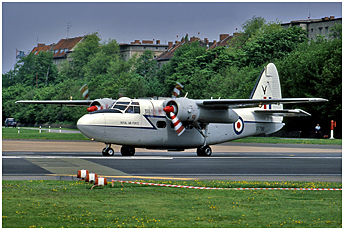 On returning to RAF Wildenrath the Pembroke would be parked up again, or taken into
the hangars. The film would be quickly removed and taken with the crew over to HQ
RAFG. The films were processed as a high priority, often within a couple of hours.
Whilst that was being done the crew, particularly the navigators, would be de-briefed.
Once printed the Photographic Interpreters would look over the pictures to derive
whatever intelligence they could. This was undertaken by the co-located RAF
Photographic Interpretation/Intelligence Department (PID) and BAOR's (1) 6 Intelligence
Company (which also used other designations over the years) reporting to their
respective Headquarters.
Targets for the Pembrokes flights were a mixture of permanent fixed sites, temporary
operating locations and mobile equipment. Some, like missile emplacements and
airfields were routinely covered - looking for new equipment or any changes on the
ground. Training areas were also popular too - particularly during exercise seasons. As
Andy Scott, OC of the photo Interpretation Flight and later Operations Officer in PID,
from mid 1977-80 told us, "BRIXMIS and Pembroke operations sometimes tallied in
because they could direct us and we could direct them."
PID and 6 Intelligence Company used information from a wide range of UK and allied
sources, including BRIXMIS activities and 60 Squadron flights. "We maintained target
folders and produced a monthly activity summary and Orders of Battle (ORBAT). We
concentrated on 'air' related material - so we did electronics, airfields and the SAM
sites. 6 Intelligence Company concentrated on army installations and formations -
mainly the barracks, looking for changes."
On returning to RAF Wildenrath the Pembroke would be parked up again, or taken into
the hangars. The film would be quickly removed and taken with the crew over to HQ
RAFG. The films were processed as a high priority, often within a couple of hours.
Whilst that was being done the crew, particularly the navigators, would be de-briefed.
Once printed the Photographic Interpreters would look over the pictures to derive
whatever intelligence they could. This was undertaken by the co-located RAF
Photographic Interpretation/Intelligence Department (PID) and BAOR's (1) 6 Intelligence
Company (which also used other designations over the years) reporting to their
respective Headquarters.
Targets for the Pembrokes flights were a mixture of permanent fixed sites, temporary
operating locations and mobile equipment. Some, like missile emplacements and
airfields were routinely covered - looking for new equipment or any changes on the
ground. Training areas were also popular too - particularly during exercise seasons. As
Andy Scott, OC of the photo Interpretation Flight and later Operations Officer in PID,
from mid 1977-80 told us, "BRIXMIS and Pembroke operations sometimes tallied in
because they could direct us and we could direct them."
PID and 6 Intelligence Company used information from a wide range of UK and allied
sources, including BRIXMIS activities and 60 Squadron flights. "We maintained target
folders and produced a monthly activity summary and Orders of Battle (ORBAT). We
concentrated on 'air' related material - so we did electronics, airfields and the SAM
sites. 6 Intelligence Company concentrated on army installations and formations -
mainly the barracks, looking for changes."
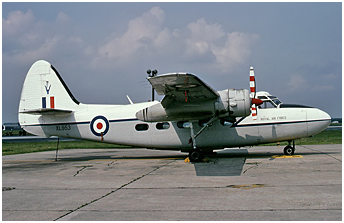 "We worked round a series of 'tip-offs' -
BRIXMIS was one of them and anything from other sources in the intelligence world
that would help us identify opportunities. Targets were selected by the RAF Ops
Officer and his Army counterpart deciding what each wanted to see, combining these
with bids from other organizations and then coordinating with other collection agencies
to avoid duplication. We had long maps of each Air Corridor and the Berlin Control Zone. These
had all the fixed targets marked on them. For individual flights some targets were
selected because we thought something interesting was going on there, and others
photographed as a matter of routine. The flights also monitored Soviet exercises in
training areas, such as the Letzlinger Heide on the Centre Corridor." That plan would
then be authorised by very senior staff in HQ RAF Germany. Once approved, the
mission could then be briefed to the crew flying the Corridor.
When particularly high priority targets were identified they would often be examined by
both BRIXMIS and 60 Squadron. For example, the arrival of the SA-2 Guideline Missile
at Glau in East Germany, during 1958, was first detected by 60 Squadron as
preparation work began on the site. As a result BRIXMIS were tasked to explore the
area and over time it became clear that this was to be a missile site, rather than the
more usual anti-aircraft gun emplacements of the time.
If a Pembroke had ever been forced to land in the GDR, a prepared cover story was to be used.
However, it was unlikely to last much longer than the time it took to recount. An Appendix
to the 1962 'Operations Instruction' illustrates this. Providing the aircraft lands intact,
it starts with the admission that 'the aircraft is used for aerial photography on legitimate
occasions'. They instruct that the purpose of the flight was to 'bring up to date the survey
of Gatow airfield', and that any exposed 'operational' film magazines are to be 'fogged'
(they were rewinded and exposed to a bright light) and
exchanged with 'cover' ones by the crew. The cover magazines contained either unexposed film or
footage of RAF Gatow. The crews were also told that they could set fire to the aircraft, but
quite how this was to be done was not made clear. In National Archive material, ministerial and
official exchanges often express the view that the possibility of losing a Pembroke due to engine
problems was relatively insignificant because it was a twin-engined aircraft. However, the
aircrews themselves often mention the Pembroke's abysmal single-engined performance, especially when
operating at close to maximum take-off weight as the 'in fit' aircraft did.
Dave Clark also explained another trick to keep the Operation deniable in case of a forced landing:
"One cover story was that we were flying an
urgent replacement part into Berlin and were using the only available aircraft, which just
happened to be in camera fit." Peter Jefferies explained some of the background work
that tried to keep the deception plausible: "To accompany the spare part it had to have
appropriate RAF paperwork but that would have involved bringing the Wildenrath
Movements Squadron in on the act. To avoid that quite a competition developed, over
the years among Hallmark cleared personnel, as to who could best forge the various
Movement Officers' signatures."
"We worked round a series of 'tip-offs' -
BRIXMIS was one of them and anything from other sources in the intelligence world
that would help us identify opportunities. Targets were selected by the RAF Ops
Officer and his Army counterpart deciding what each wanted to see, combining these
with bids from other organizations and then coordinating with other collection agencies
to avoid duplication. We had long maps of each Air Corridor and the Berlin Control Zone. These
had all the fixed targets marked on them. For individual flights some targets were
selected because we thought something interesting was going on there, and others
photographed as a matter of routine. The flights also monitored Soviet exercises in
training areas, such as the Letzlinger Heide on the Centre Corridor." That plan would
then be authorised by very senior staff in HQ RAF Germany. Once approved, the
mission could then be briefed to the crew flying the Corridor.
When particularly high priority targets were identified they would often be examined by
both BRIXMIS and 60 Squadron. For example, the arrival of the SA-2 Guideline Missile
at Glau in East Germany, during 1958, was first detected by 60 Squadron as
preparation work began on the site. As a result BRIXMIS were tasked to explore the
area and over time it became clear that this was to be a missile site, rather than the
more usual anti-aircraft gun emplacements of the time.
If a Pembroke had ever been forced to land in the GDR, a prepared cover story was to be used.
However, it was unlikely to last much longer than the time it took to recount. An Appendix
to the 1962 'Operations Instruction' illustrates this. Providing the aircraft lands intact,
it starts with the admission that 'the aircraft is used for aerial photography on legitimate
occasions'. They instruct that the purpose of the flight was to 'bring up to date the survey
of Gatow airfield', and that any exposed 'operational' film magazines are to be 'fogged'
(they were rewinded and exposed to a bright light) and
exchanged with 'cover' ones by the crew. The cover magazines contained either unexposed film or
footage of RAF Gatow. The crews were also told that they could set fire to the aircraft, but
quite how this was to be done was not made clear. In National Archive material, ministerial and
official exchanges often express the view that the possibility of losing a Pembroke due to engine
problems was relatively insignificant because it was a twin-engined aircraft. However, the
aircrews themselves often mention the Pembroke's abysmal single-engined performance, especially when
operating at close to maximum take-off weight as the 'in fit' aircraft did.
Dave Clark also explained another trick to keep the Operation deniable in case of a forced landing:
"One cover story was that we were flying an
urgent replacement part into Berlin and were using the only available aircraft, which just
happened to be in camera fit." Peter Jefferies explained some of the background work
that tried to keep the deception plausible: "To accompany the spare part it had to have
appropriate RAF paperwork but that would have involved bringing the Wildenrath
Movements Squadron in on the act. To avoid that quite a competition developed, over
the years among Hallmark cleared personnel, as to who could best forge the various
Movement Officers' signatures."
What about the Soviets?
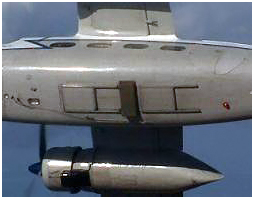 Les deux trappes ventrales faisant saillie sous le ventre d'un Pembroke du Squadron 60
peuvent être clairement observée sur cette vue. Le carénage rectangulaire situé entre elles et commun à
tous les Pembrokes photo de l'unité, demeure non identifié. © DR.
Les deux trappes ventrales faisant saillie sous le ventre d'un Pembroke du Squadron 60
peuvent être clairement observée sur cette vue. Le carénage rectangulaire situé entre elles et commun à
tous les Pembrokes photo de l'unité, demeure non identifié. © DR.
The two camera hatches protruding under the belly of a Pembroke from No 60 Squadron
can be clearly observed on this underside view. The rectangular fairing between them, common to all photo Pembrokes of the unit,
remains unidentified. © DR.
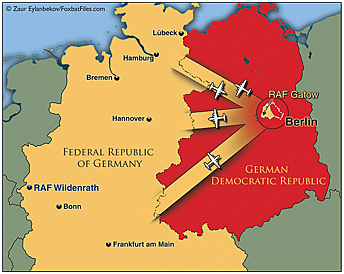 Did the Soviets know what was going on? In all they must surely have done so. There
is anecdotal information indicating that the Russians had a very clear picture of US C-130
reconnaissance flights along the corridor. All the signs were there and the Soviets
were unlikely to have missed them. As pilot Brian King told us, "I once took my family
to West Berlin for some leave. Whilst there I heard a familiar engine tone and looked
up to see this Pembroke flying an unmistakable photographic pattern over the City."
Andy Scott also mentioned that on one occasion "a Pembroke was flown over
Rheindahlen to take some photographs of the Headquarters buildings. As it came over
you could see the hatch open underneath and a camera shutter moving so I don't think
it ever fooled the Russians!" Phil Chaney recalled that on another occasion, "one week
before Christmas at an airfield on the Centre Corridor
(2) trampled out in the thick snow,
just in front of the tower, in English and in time for the routine Pembroke's overflight was
- "Happy Christmas."
Phil Chaney also recounted one contact with the Soviets around 1980: "I remember
being at a darts match at the Gatow Officers' Mess one night against members of the
Berlin Air Safety Centre (UK, US, French and Soviet). While I was playing against the
Russian Colonel, he turned to me and asked, very slowly, if I was visiting on 'The
Pembroke' - then winked!"
There were incidents of 'near misses', but these were generally attributed to accident
rather than deliberate action. However, during periods of heightened tension, either
over Berlin itself, or internationally, there were occasions when Pembrokes were
'intercepted' by close fly-bys, sometimes dangerously so. Andy Scott recounted one
incident, that could have been catastrophic: "I remember talking once to a very shaken
Pembroke crew. They had been flying close to Werneuchen airfield (on the very Eastern
edge of the Berlin Control Zone) where Soviet 'Foxbats' were based. Whilst flying along taking
photographs, a Foxbat came up from underneath them right in front of their nose in a
steep climb. They were lucky they didn't hit the wake as that could have downed them.
I think that incident was by design rather than accident."
Did the Soviets know what was going on? In all they must surely have done so. There
is anecdotal information indicating that the Russians had a very clear picture of US C-130
reconnaissance flights along the corridor. All the signs were there and the Soviets
were unlikely to have missed them. As pilot Brian King told us, "I once took my family
to West Berlin for some leave. Whilst there I heard a familiar engine tone and looked
up to see this Pembroke flying an unmistakable photographic pattern over the City."
Andy Scott also mentioned that on one occasion "a Pembroke was flown over
Rheindahlen to take some photographs of the Headquarters buildings. As it came over
you could see the hatch open underneath and a camera shutter moving so I don't think
it ever fooled the Russians!" Phil Chaney recalled that on another occasion, "one week
before Christmas at an airfield on the Centre Corridor
(2) trampled out in the thick snow,
just in front of the tower, in English and in time for the routine Pembroke's overflight was
- "Happy Christmas."
Phil Chaney also recounted one contact with the Soviets around 1980: "I remember
being at a darts match at the Gatow Officers' Mess one night against members of the
Berlin Air Safety Centre (UK, US, French and Soviet). While I was playing against the
Russian Colonel, he turned to me and asked, very slowly, if I was visiting on 'The
Pembroke' - then winked!"
There were incidents of 'near misses', but these were generally attributed to accident
rather than deliberate action. However, during periods of heightened tension, either
over Berlin itself, or internationally, there were occasions when Pembrokes were
'intercepted' by close fly-bys, sometimes dangerously so. Andy Scott recounted one
incident, that could have been catastrophic: "I remember talking once to a very shaken
Pembroke crew. They had been flying close to Werneuchen airfield (on the very Eastern
edge of the Berlin Control Zone) where Soviet 'Foxbats' were based. Whilst flying along taking
photographs, a Foxbat came up from underneath them right in front of their nose in a
steep climb. They were lucky they didn't hit the wake as that could have downed them.
I think that incident was by design rather than accident."
MiG Interception
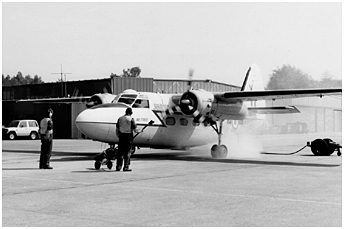
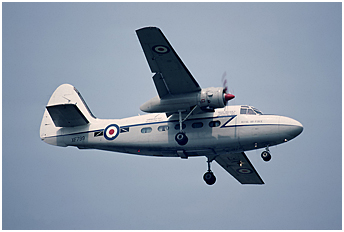 One of the most serious incidents of harassment encountered by a Pembroke, was
accidental. On 17th January 1972 XL954 was intercepted by 3 MiG-17's. Rob Fallon,
one of the Navigators on that day, described how the Pembroke was flying close to the
edge of the Southern Corridor and suddenly started bouncing around as the MiGs
thundered by in close proximity and in quick succession. "Immediately the radio
became very frantic and we were moved onto our discrete frequency. The pilot lowered
the undercarriage and flaps and brought XL954 down close to its stall speed and moved
us back South towards the Corridor centreline. Meanwhile the second navigator was
bouncing around in the back, rewinding the film to spoil it, expecting that we might have
to force land. Our cover story suddenly looked very thin. I had been reading various
books by Alexsandr Solyhenitsyn at the time and had visions that, even if very lucky,
we might end up in Siberia for an extremely long time!
The MiG-17's couldn't compete with our slow speed so carried on circling in order to
stay with us. Soon another aircraft, this time a MiG-21, came up. It flew on a reciprocal
heading beneath us and we were close enough to see the pilot looking up and waving.
We could easily see the missiles loaded under the wings, he was probably at around
2,000 feet. Radar was talking to us continually and monitored the MiG's approach. In
addition, we could hear the crews of both types of aircraft talking in Russian as it was
breaking through on the radio. This was another first for the Intelligence people as they
had been told that all the aircraft on CAP over the GDR at that time were operated only
by East Germans.
After the event we received an apology for the incident through the Berlin Air Safety
Centre. The Russian excuse for the incident was that a trainee radar operator
monitoring the Corridors had mis-plotted an aircraft so that it had an apparent ground
speed of 600 knots. Checking inbound flight plans to Berlin the only thing around was
a twin-engined RAF aircraft and the trainee made the assumption that this was one of
the, then new, RAF Phantom's commencing an attack run to Berlin to start World War
Three! We were told that we were not shot down or forced to land because the first
CAP MiG-17 to buzz us told his control that we were not a Phantom and perhaps they
should check again."
In the RAF Gatow Operation Record Book, the report on the incident notes: "this incident
was reported to BASC and later, the Chief American Controller, who controls the South
Corridor, obtained through the Chief Russian Controller, an admission of error and an
apology. This reaction was unique in that it was the first on-the-record Russian apology
in BASC that anyone here can currently recall."
One of the most serious incidents of harassment encountered by a Pembroke, was
accidental. On 17th January 1972 XL954 was intercepted by 3 MiG-17's. Rob Fallon,
one of the Navigators on that day, described how the Pembroke was flying close to the
edge of the Southern Corridor and suddenly started bouncing around as the MiGs
thundered by in close proximity and in quick succession. "Immediately the radio
became very frantic and we were moved onto our discrete frequency. The pilot lowered
the undercarriage and flaps and brought XL954 down close to its stall speed and moved
us back South towards the Corridor centreline. Meanwhile the second navigator was
bouncing around in the back, rewinding the film to spoil it, expecting that we might have
to force land. Our cover story suddenly looked very thin. I had been reading various
books by Alexsandr Solyhenitsyn at the time and had visions that, even if very lucky,
we might end up in Siberia for an extremely long time!
The MiG-17's couldn't compete with our slow speed so carried on circling in order to
stay with us. Soon another aircraft, this time a MiG-21, came up. It flew on a reciprocal
heading beneath us and we were close enough to see the pilot looking up and waving.
We could easily see the missiles loaded under the wings, he was probably at around
2,000 feet. Radar was talking to us continually and monitored the MiG's approach. In
addition, we could hear the crews of both types of aircraft talking in Russian as it was
breaking through on the radio. This was another first for the Intelligence people as they
had been told that all the aircraft on CAP over the GDR at that time were operated only
by East Germans.
After the event we received an apology for the incident through the Berlin Air Safety
Centre. The Russian excuse for the incident was that a trainee radar operator
monitoring the Corridors had mis-plotted an aircraft so that it had an apparent ground
speed of 600 knots. Checking inbound flight plans to Berlin the only thing around was
a twin-engined RAF aircraft and the trainee made the assumption that this was one of
the, then new, RAF Phantom's commencing an attack run to Berlin to start World War
Three! We were told that we were not shot down or forced to land because the first
CAP MiG-17 to buzz us told his control that we were not a Phantom and perhaps they
should check again."
In the RAF Gatow Operation Record Book, the report on the incident notes: "this incident
was reported to BASC and later, the Chief American Controller, who controls the South
Corridor, obtained through the Chief Russian Controller, an admission of error and an
apology. This reaction was unique in that it was the first on-the-record Russian apology
in BASC that anyone here can currently recall."
Enter the Andover
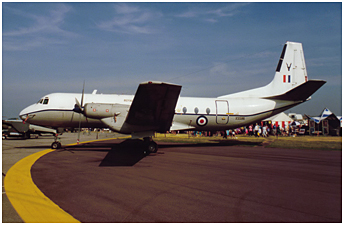 A replacement for the Pembroke had been talked about since the early 1970s but it was
not until the 1980s that the Andover was finally agreed upon. Two aircraft were selected
for conversion, but only XS596 was ever completed (XS596 later became the British
'Open Skies' aircraft). That programme took several years more than planned because
of the difficulties in integrating the various new sensor package elements into the
Andover. The aircraft was delivered to the Squadron in summer 1989 but required
further modification at Wildenrath. This included the fitting of a false bulkhead and seats
in the rear of the aircraft. Thus when the rear doors of the Andover were opened all
anyone would see would be an aircraft in a passenger configuration. Operational flights
began early in 1990 - after the collapse of the Wall. Indeed both Pembrokes and
Andovers were flown in an overlap period in support of Operation Hallmark with
some final Pembroke flights being recorded into March 1990.
On 7 December 1989, 60 Squadron flew former Chancellor Willy Brandt into the City.
When the Wall had been erected in 1961, Brandt had been West Berlin's Mayor and he
had promised to come back and see it dismantled. 60 Squadron was able to help him
keep that promise.
Paul Hickley described the final months of flying: "We had virtually ceased operations
by August 1990. It was not, as far as I recall, that the operation was officially cancelled,
just that the tasking requests dried up because the operation had become pointless in
view of impending German reunification." Operation Hallmark was officially finished on
30th September 1990. However the last full flight had one final, unexpected twist. 60
Squadron CO, Phil Chaney described: "Our final Hallmark flight was on 6th September
1990. Take off was delayed because the RAF Wildenrath armoury was on fire.
Eventually we got off and flew to Berlin along the Corridor (which by now had become
a formal civil airway). On our return we overflew the site of the armoury, which was now
a roofless smouldering shell, using our few remaining feet of film. Those last few feet
of the final Hallmark film were declassified and released to the President of the Board
of Inquiry into the fire. He was astounded to find such high quality imagery was
available to aid his investigation." It seems that Operation Hallmark had kept some of
its secrets, if not from the Soviets, right to the very end.
A replacement for the Pembroke had been talked about since the early 1970s but it was
not until the 1980s that the Andover was finally agreed upon. Two aircraft were selected
for conversion, but only XS596 was ever completed (XS596 later became the British
'Open Skies' aircraft). That programme took several years more than planned because
of the difficulties in integrating the various new sensor package elements into the
Andover. The aircraft was delivered to the Squadron in summer 1989 but required
further modification at Wildenrath. This included the fitting of a false bulkhead and seats
in the rear of the aircraft. Thus when the rear doors of the Andover were opened all
anyone would see would be an aircraft in a passenger configuration. Operational flights
began early in 1990 - after the collapse of the Wall. Indeed both Pembrokes and
Andovers were flown in an overlap period in support of Operation Hallmark with
some final Pembroke flights being recorded into March 1990.
On 7 December 1989, 60 Squadron flew former Chancellor Willy Brandt into the City.
When the Wall had been erected in 1961, Brandt had been West Berlin's Mayor and he
had promised to come back and see it dismantled. 60 Squadron was able to help him
keep that promise.
Paul Hickley described the final months of flying: "We had virtually ceased operations
by August 1990. It was not, as far as I recall, that the operation was officially cancelled,
just that the tasking requests dried up because the operation had become pointless in
view of impending German reunification." Operation Hallmark was officially finished on
30th September 1990. However the last full flight had one final, unexpected twist. 60
Squadron CO, Phil Chaney described: "Our final Hallmark flight was on 6th September
1990. Take off was delayed because the RAF Wildenrath armoury was on fire.
Eventually we got off and flew to Berlin along the Corridor (which by now had become
a formal civil airway). On our return we overflew the site of the armoury, which was now
a roofless smouldering shell, using our few remaining feet of film. Those last few feet
of the final Hallmark film were declassified and released to the President of the Board
of Inquiry into the fire. He was astounded to find such high quality imagery was
available to aid his investigation." It seems that Operation Hallmark had kept some of
its secrets, if not from the Soviets, right to the very end.
© Dr. Kevin Wright
Thanks to: Brian King, Dave Clark, Dallas Payne, Phil Chaney, Paul Hickley, Andy Scott, Rob Fallon, Peter Jefferies, the Medmenham Collection, RAF Air Historical Branch, MAcr Rick Cooke and the 60 Squadron Association for their time and great patience.
This article was initially published in the March 2011 issue of Aircraft (Ian Allan Publishing). With special thanks to Kevin Wright, author and Ben Dunnell, Editor. It has been updated with extracts from the book of Keving Wright and Peter Jefferies, entitled "Looking Down the Corridors" published in 2015 (see > Multimedia).
Paul Hickley, who was a navigator with 60 Squadron, wrote a book entitled "Holding to the Heavens"
to celebrate the 100th anniversary of the Squadron in 2016.
He kindly gave us permission to upload the chapters relevant to Operation Hallmark.
You can read them > HERE.
You will find all the necessary information about that book in the Multimedia section.
> Look at the BCZ and the Berlin air corridors on Google Earth: download the file entitled
"Luftraum Berlin und DDR 198x"
Choose carefully your options if you don't want to be overwhelmed with information.
notes
(1) BAOR: British Army Of the Rhine
(2)
Mahlwinkel
 |
The Hunting Pembrokes < Part 1 |
 |
Plan du site - Sitemap |  |
